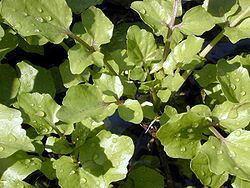Watercress
| Watercress | |
|---|---|

| |
| Nasturtium microphyllum, a watercress | |
| Scientific classification | |
| Kingdom: | |
| Phylum: | |
| Class: | |
| Order: | |
| Family: | |
| Genus: | |
| Species | |
|
Nasturtium microphyllum (Boenn.) Rchb. | |
Watercresses (Nasturtium officinale, N. microphyllum; formerly Rorippa nasturtium-aquaticum, R. microphylla) are fast-growing, aquatic or semi-aquatic, perennial plants native from Europe to central Asia, and one of the oldest known leaf vegetables consumed by human beings. These plants are members of the Family Brassicaceae or cabbage family, botanically related to garden cress and mustard — all noteworthy for a peppery, tangy flavour.
The hollow stems of watercress are floating and the leaves are pinnately compound. Watercresses produce small white and green flowers in clusters.
Nasturtium nasturtium-aquaticum (nomenclaturally invalid) and Sisymbrium nasturtium-aquaticum L. are synonyms of N. officinale. Nasturtium officinale var microphyllum (Boenn. ex Reich.) Thellung is a synonym of N. microphyllum (ITIS, 2004). These species are also listed in some sources as belonging to the genus, Rorippa, although molecular evidence shows that the aquatic species with hollow stems are more closely related to Cardamine than Rorippa (Al-Shehbaz & Price, 1998). Watercresses are not related to the flowers in the genus, Tropaeolum (Family Tropaeolaceae), popularly known as "nasturtiums".
Watercress cultivation
Cultivation of watercress is practical on both a large scale and a garden scale. Being semi-aquatic, watercress is well-suited to hydroponic cultivation, thriving best in water that is slightly alkaline. It is frequently produced around the headwaters of chalk streams. In many local markets the demand for hydroponically-grown watercress exceed supplies. This is due in part to the fact that cress leaves are unsuitable for distribution in dried form and can only be stored for a short period.
However (in the UK at least), the packaging used by supermarkets using sealed plastic bags under some internal pressure (a plastic envelope containing moisture and pressurised (inflated) to prevent crushing of contents) has allowed the distribution of watercress (and sometimes a mixture of it with other salad leaves). This has allowed national availability with a once purchased storage life of 1 - 2 days in chilled/refrigerated storage.
If unharvested, watercress can grow to a height of 50-120 cm. Also sold as sprouts, the edible shoots are harvested days after germination.
Like many plants in this family, the foliage of watercress becomes bitter when the plants begin producing flowers.
Huntsville, Alabama now uses the slogan "Rocket City", but before it developed a missile industry it called itself the "Watercress Capital of the World".[1]
Watercress is one of the main ingredients in V8® Vegetable Juice. Watercress is often used in sandwiches, such as those made for afternoon tea.
Watercress is grown in a number of counties of the UK, most notably, Hampshire, Wiltshire and Dorset. Alresford, near Winchester, is often considered the watercress capital of Britain (to the extent that a steam railway line us named after the famous local crop). In recent years, watercress has become more widely available in the UK, at least in the South-East, being stocked pre-packed in some supermarkets, as well as fresh by the bunch at farmers' markets and greengrocers. Value-added produce such as the traditional watercress soup, as well as watercress pesto are increasingly easy to source.
Nutritional value
Watercress contains significant amounts of iron, calcium and folic acid, in addition to vitamins A and C.[2] In some regions watercress is regarded as a weed, in other regions as an aquatic vegetable or herb. Where watercress is grown in the presence of animal waste, it can be a haven for parasites such as the liver fluke Fasciola hepatica.[citation needed]
Many benefits from eating watercress are claimed, such as that it acts as a mild stimulant, a source of phytochemicals and antioxidants, a diuretic, an expectorant, and a digestive aid.[citation needed] It also appears to have cancer-suppressing properties.[2]
References
- Al-Shehbaz, I. and R. A. Price. 1998. Delimitation of the genus Nasturtium (Brassicaceae). Novon, 8: 124-126.
